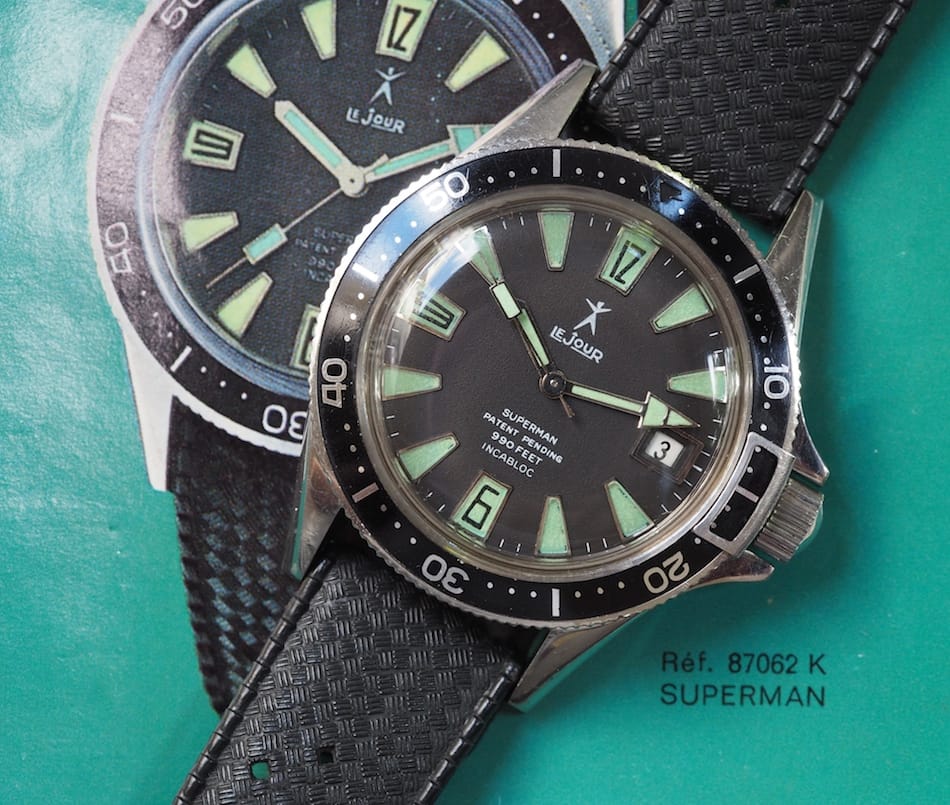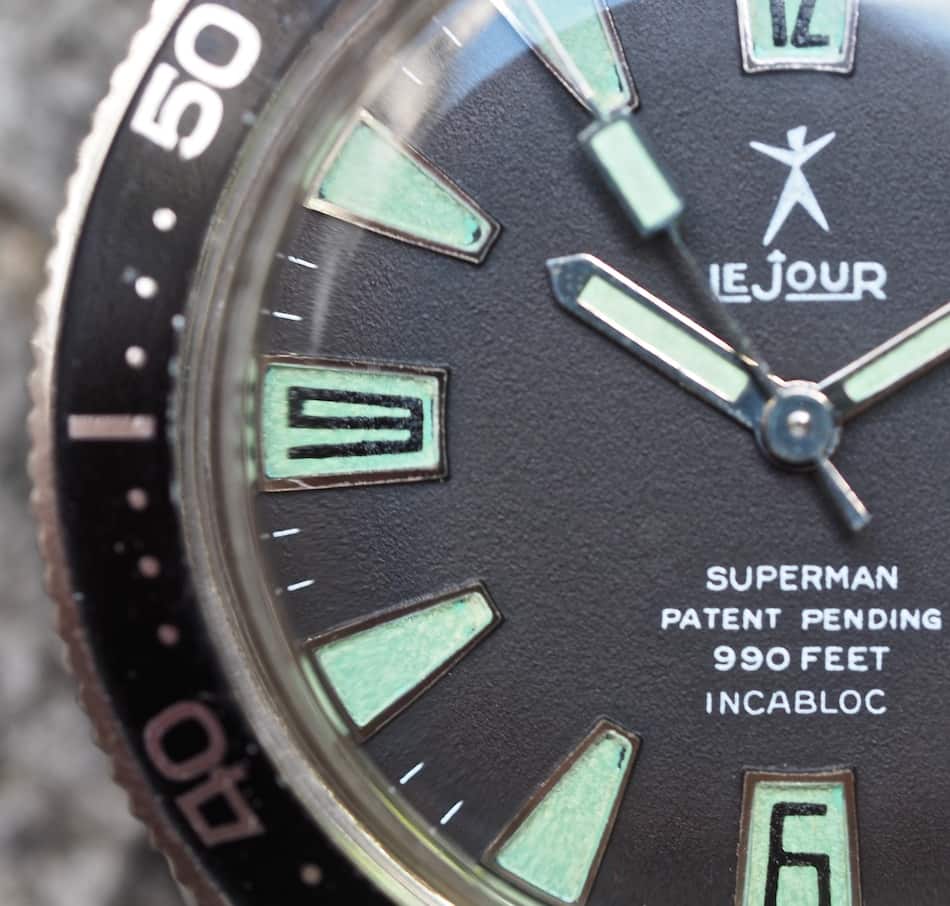#TBT The Yema Superman – An Early Diver With a Locking Bezel
In June of 2017, I wrote an article about the Yemas that were up for sale at an upcoming Watches of Knightsbridge auction. I felt that the watches were nice, but priced at or around the market. I ended up attending the auction, it coincided with other business I had in town, and I came away highly surprised with the results. A 7736-powered “formica dial” Rallye chronograph sold for 4500 GBP before commission and a “Brown Sugar” chronograph sold for an astounding 7500 GBP before “the juice”. Perhaps I’ve been asleep at the wheel, but it all adds up to the fact that Yema is hot right now and people are clearly after them. Here on #TBT, and in the auction review article, we’ve focused entirely on chronographs. Today, though, we’ll turn our attention to another style of watch because the plucky French marque did make other styles. In fact, I’d say that today’s subject is even more historically significant. The Yema Superman is our target, albeit in LeJour guise, so let’s take a look.

The Yema Superman – A Historic Diver
We’ve chronicled many subterranean watches on #TBT in an effort to show the various attempts, and the innovations deployed, at making the perfect dive watch. Some, such as the Doxa 300 or Phillip Caribbean, offered unique bezels to make diving safer before the advent of the trusty dive computer. Others, such as the Seiko 6105, added a strange locking crown that clearly didn’t make it past a one model run. The Rolex Red Submariner was viewed and most would say that it ranks as one of the more perfect specimens in terms of clarity, simplicity and functionality. And, finally, we most recently looked at the Rado Captain Cook as an early 1960’s diver that used a strange concave bezel found on some other early watches. Fear not, today’s look at the Yema Superman won’t be our last foray into dive watches that tried to add something new, but it’s a worthwhile piece to discuss.

The Superman Debuted in 1963
The Yema Superman was introduced in 1963. With a depth rating of 300 meters, I’ve seen forum postings stating that this watch was the first “mass market” deep diver. Granted, it all depends on how one defines mass market, but let’s posit that the watch likely qualified as relatively affordable versus the big Swiss brands that didn’t even offer such capabilities and was, therefore, suited for a wide range of buyers. As for goofy early dive watch innovation, the Superman doesn’t disappoint.

Innovation on the Yema Superman
A quick glance at the Yema Superman would suggest a conventional diver with a rotating bezel, but on closer inspection, one notices a bracket at 3:00. The bracket overlays on top of the bezel and creates a window so as to obscure as little of the scale as possible. It’s affixed to the watch by surrounding the crown stem and when the crown is unscrewed, the bracket dangles.

The purpose of the bracket, you ask? It’s quite simple and quite elegant: locking the bi-directional bezel once set. The Superman’s bezel is knurled on the outside and a very close look at the inside of the bezel lock bracket shows that it has “claws” to grip the knurling, thereby locking it into place.

You may not think that this is a big deal, but consider that bezels back in the early 1960’s were bi-directional and often non-clicking. Yes, this seems to be the first locking dive bezel. As an aside, the idea of screwing and unscrewing a crown to allow a bezel to rotate isn’t foreign; we reviewed a Glycine Airman that follows the same general principal.

A Locking Dive Bezel
You also might say that the locking dive bezel on the Yema Superman isn’t all that useful since there haven’t been many watches with such a mechanism since, but it’s significant because watch companies have gone to great length to ensure bezels don’t move. As mentioned, unidirectional clicking bezels that take serious effort to turn are a sign of quality and safety. Then, think of the original Ploprof with its locking bezel (mimicked by Squale with its Tiger) and the Tuna with its shroud. The latter pieces were designed for professionals, so consider the Yema as a watch with serious intentions.

The downfall of the Superman’s design, though, is that the crown needs to be unscrewed in order to turn the bezel and that seems a bit risky and impractical. I suppose it might always be possible to do it in the dry, but I’d think that adjusting the watch while in the water or with wet gloves while on a boat is more typical behavior.

Bezel locking mechanism aside, the Yema Superman could quickly be passed off as a traditional looking diver. Remember, though, you’re looking at 1963 and aside from the Submariner and, perhaps, the Seamaster 300, I’d argue that the case design qualifies as pretty modern compared to most other early divers with their often svelte and elegantly styled cases.

It also foreshadows things to come at the brand because the design is similar in style to the Yema chronographs we all know and enjoy. In this execution, it’s fully stainless at 39mm in diameter with a 19mm lug width. Likewise, the watch contains large crown guards and an equally large crown (complete with a “stepped” look like on most watches from Yema). The Yema embossed case back is screw down and like most watches of this era, it contains a thick, domed acrylic crystal.

Funky Green Lume
Moving onto the dial, the Yema Superman contains, once again, a fairly traditional dial and hands set. Huge green, framed lume plots describe the hour indices with numerals inside these at 6/9/12. This style of numbers within the plots is seen on early divers such as the Zodiac Sea Wolf and the Eterna Kon Tiki; it’s a cool look that’s come back into vogue as the aforementioned watches have now been reissued. The hands are typical 60’s diver with an arrow shaped minutes hand that’s pretty purposeful for a diver. And how about that green lume? It may look like a questionable relume, but it’s real, it’s typical, and emits briefly under a black light.

A LeJour is a Yema for the USA
I mentioned that the Yema Superman you’re staring it is actually badged as a LeJour. We’ve discussed the fact that LeJour was nothing more than a Yema rebadged for US sale. The funny thing, and again it’s normal, is that watch contains a Yema case back. No, it didn’t seem to take much to take much to skirt customs back in the day other than a simple name change on the dial. Yema versions, by the way, are identical aside from the name on the dial. As referenced, the watch you are looking at here is the earliest edition of the Superman. I’d recommend taking a gander here to see the many different editions that followed. Pay particular attention to editions with acrylic bezels, blue dials, and sweep seconds hands very similar to the Seiko 6105 (remember, Yema was owned by Seiko for a period).

The Yema Superman Uses a French Movement
Movement wise, the Yema Superman contains something I’ve not really come upon before, the French Ebauches “FE” 3611. It’s a 17-jewel automatic with date and runs at 21,600 bph. It can be manually wound. According to Ranfft, this is a “strange” movement due to the train and hand gear being driven separately by its barrel. It allows for a slimmer design (not really evidenced by the watch overall), but requires serious precision. Whatever the case, the good thing is that there are plenty of these movements floating around if repairs are needed and it does keep great time.

Another detail is worth mentioning. When taking a look at the original Yema Superman brochure, it doesn’t take long to notice that the bezel clip shows as red. These clips were painted and it’s extremely rare to find one with any traces of color. That’s not a surprise, though, as the screw down crown grinds into the lock, while pushing it up against the case, and the actual locking teeth press up against the knurling. I’m torn as to whether I’ll buy some red enamel and hand paint the lock myself – let’s see!

A Tropic Strap is Perfect on the Superman
You’ll see that I’ve attached a Tropic to the Yema Superman in the vein of what originally came with the watch. In all actuality, it’s a semi-vintage Hong Kong-made strap made from the Tropic molds that were shipped there after the original brand went out of business. After using my trusty pocketknife to remove the copious amounts of flash, I think it now looks pretty good and certainly appropriate. You can see that 39mm looks nice on the wrist and the somewhat beefy case thickness helps give the watch the appearance of more size than most divers of its age. When looking for a Superman, aside from remembering to watch out for the bezel lock, check the usual things like the condition of the dial and hands. There’s little else to concern yourself with, as these are fairly simple. Note that LeJour versions are essentially priced at the same level as the Yemas. What do these cost today? Assume somewhere in the realm of $1500 – 2500 for a solid watch. This is a far cry from the $500 – 800 that these cost just a year or so ago, but I still consider it relatively affordable for a significant, and well-made, vintage diver. I was fortunate to pick up this little-used example from Andreas at My Local Time and as you can see from above, it even came with the original instruction manual!

Overall, I admire chronographs far more than any other style of watch, but in an odd turn of events, I favor the Yema Superman over the popular Rallyes and the various “grafs”. I like the clean looks and the fact that there’s some innovation – no matter how minor. The Superman has become more difficult to track down owing to its popularity amongst collectors. I’d recommend tracking one down while they’re still relatively affordable.


















